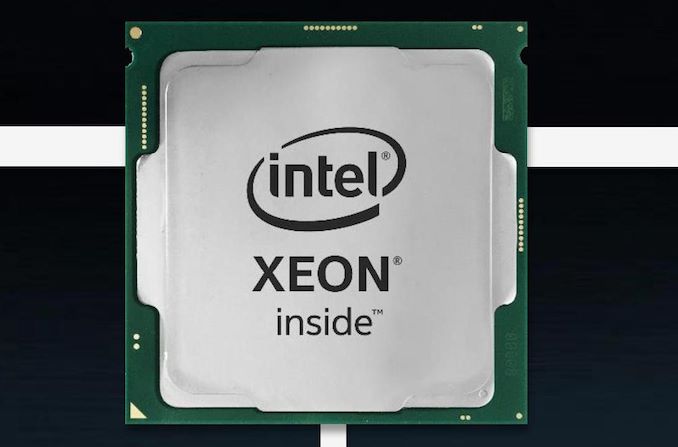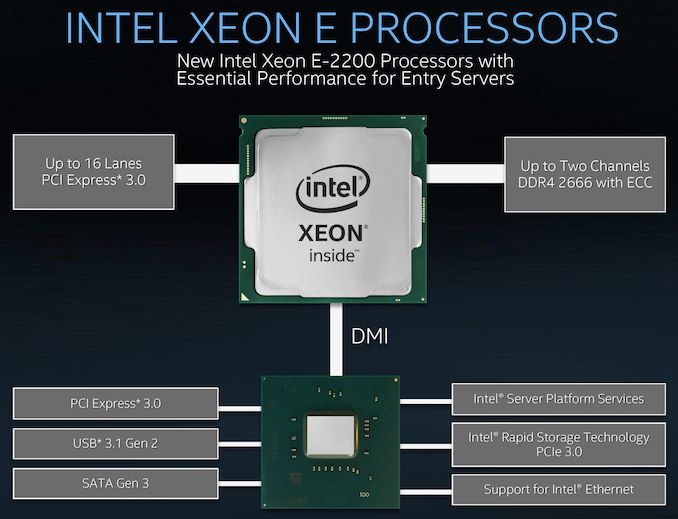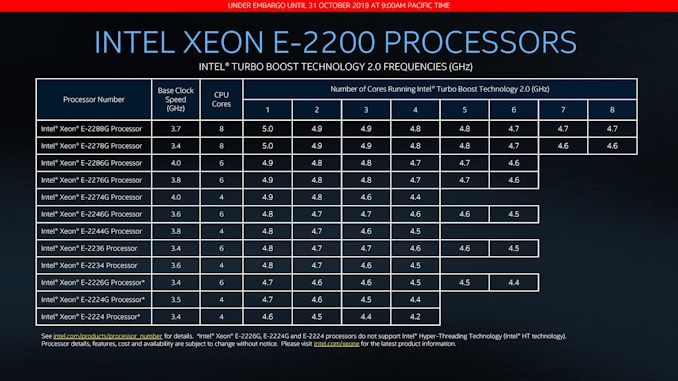Intel Launches Xeon-E 2200 Series for Servers: 8 Cores, up to 5.0 GHz
by Dr. Ian Cutress on November 4, 2019 10:00 AM EST
The Xeon-E family from Intel replaced the Xeon E3-1200 parts that were found common place in a lot of office machines and small servers. The Xeon E parts are almost direct analogues of the current leading consumer processor hardware, except with ECC memory support and support for vPro out of the box. Today’s launch is a secondary launch, with Intel having released the Xeon-E 2200 series some time ago for the cloud market, but this launch marks general availability for consumers and the small-scale server market.
The main market for Xeon E tends towards small and medium businesses that want an internal office infrastructure that can be managed remotely but also tend to run critical applications that absolutely can’t fail a rogue bit-flip in memory. This typically means traders and banks, as well as medical environments, but also Intel has forever expanded this into SMB server deployments, either as a local cloud or as part of the cloud providers, as a way to assist these businesses to scale their data requirements.
| Xeon E-2200 Family | ||||||
| AnandTech | Cores Threads |
Base Freq |
Turbo Freq |
L3 Cache |
IGP | TDP |
| 8-core | ||||||
| E-2288G | 8 / 16 | 3700 | 5000 | 16 MB | Y | 95 W |
| E-2278G | 8 / 16 | 3400 | 5000 | 16 MB | Y | 80 W |
| 6-core | ||||||
| E-2286G | 6 / 12 | 4000 | 4900 | 12 MB | Y | 95 W |
| E-2276G | 6 / 12 | 3800 | 4900 | 12 MB | Y | 80 W |
| E-2246G | 6 / 12 | 3600 | 4800 | 12 MB | Y | 80 W |
| E-2236 | 6 / 12 | 3400 | 4800 | 12 MB | - | 80 W |
| E-2226G | 6 / 6 | 3400 | 4700 | 12 MB | Y | 80 W |
| 4-core | ||||||
| E-2274G | 4 / 8 | 4000 | 4900 | 8 MB | Y | 83 W |
| E-2244G | 4 / 8 | 3800 | 4800 | 8 MB | Y | 71 W |
| E-2234 | 4 / 8 | 3600 | 4800 | 8 MB | - | 71 W |
| E-2224G | 4 / 4 | 3500 | 4700 | 8 MB | Y | 71 W |
| E-2244 | 4 / 4 | 3400 | 4600 | 8 MB | - | 71 W |
These parts are almost direct updates from the Xeon E-2100 family – they are still based on the same 14nm class manufacturing process and are on the ‘Coffee Lake Refresh’ microarchitecture, rather than just simply ‘Coffee Lake’.
Aside from some minor frequency increases (note, the base TDP has also increased from 65W to 70W to accommodate), the biggest news from this processor stack is the launch of the first Xeon E 8-core processors. The Xeon E-2288G and Xeon E-2278G have the honor of being the first 8-core Xeon Entry parts, differing in 15W TDP and 300 MHz base frequency, but both offering 5.0 GHz turbo on up to two cores.
The other thing to note is that the Xeon E-2100 family had a couple of parts in the ‘2104’ range that were OEM-only hardware for particular customers and may have had long life-cycle support depending on the customer. These parts do not appear to have an updated version.
These processors use the same LGA-1151 socket C240 motherboards as the E-2100 generation, and feature dual memory channels up to DDR4-2666 at 2 modules per channel (maximum 128 GB). The CPUs have 16 PCIe 3.0 lanes, with the chipset adding up to 24 more lanes for add-in cards and controllers. The chipset also supports six USB 3.1 ports, 10 USB 3.0 ports, and eight SATA ports for storage.
Ultimately the Xeon E option is low volume but important class for Intel. Xeon E is designed for customers that need consumer-level x86 compute hardware (but also ECC/vPro) but for general purpose or ‘entry level workstations’ – i.e. those that don’t need an intense focus on networking or PCIe lanes.
We have a couple of these processors in for review in due course.
Related Reading
- Intel Xeon E Six-Core Review: E-2186G, E-2176G, E-2146G, and E-2136 Tested
- The Xeon Entry Quad-Core CPU Review: Xeon E-2174G, E-2134, and E-2104G Tested
- Intel Has 8-Core Xeon-E at Engineering Sample Stage
- The Supermicro X11SCA-W Motherboard Review: For Entry Level Xeon
- Intel Launches Coffee Lake Xeon E (Entry): The Next-Gen E3-1200
Source: Intel












18 Comments
View All Comments
vFunct - Monday, November 4, 2019 - link
No 45 Watt low-power version? Those make great home NAS servers.speculatrix - Monday, November 4, 2019 - link
I wish Intel would stop with the hyperthreading, surely the majority of work loads will be virtualised, the gains from HT (maybe 30%) aren't worth the loss of security?And I wish they would stop reserving ECC memory for "server" chips, this will is driving me into the arms of AMD by default.
qap - Monday, November 4, 2019 - link
I don't think that 8 core cpu is going to be virtualized and shared. This looks like a very special-purpouse server. But you can always disable HT. No point in selling it without it.Plus there is a (small) chance, that they fixed this vulnerability in latest revision (they did fix some vulnerability in HW in revision used for 9900KS)
firewrath9 - Monday, November 4, 2019 - link
HT is free to intel, and as an end user if you don't like it you can always disable it.Also, they do have ECC on workstation class procs like the E-2200 (for workstation, not server) and the core i3s and pentiums also have ECC (on C24x chipsets only though)
dullard - Monday, November 4, 2019 - link
Xeon A E-2286M was also launched: https://ark.intel.com/content/www/us/en/ark/produc...2 more cores, 500 MHz lower base frequency due to the additional cores, 200 MHz higher turbo, 4 MB more cache. Same price same 45 W TDP.
dullard - Monday, November 4, 2019 - link
Full Comparison:https://ark.intel.com/content/www/us/en/ark/compar...
Ian Cutress - Monday, November 4, 2019 - link
M are the mobile chips, not the socketed desktop chips.dullard - Tuesday, November 5, 2019 - link
Ian, yes that is true. But if vFunct wants 45 W Xeon E processors, isn't mobile the way to go? Intel does not have 45 W Xeon E desktop processors that I know of.For Kaby Lake, the 45 W Xeon E was the mobile E3-1535M v6 or similar.
For 8th generation Coffee Lake, the 45 W Xeon E was the mobile 2186M or similar.
For 9th generation Coffee Lake, the 45 W Xeon E is the mobile 2286M or similar.
at8750 - Monday, November 4, 2019 - link
IntelR Xeon E-2100 and E-2200 Processor Family Datasheet, Vol. 18-Core GT2 95W PL1:95W PL2:210W TAU:28S iccMAX:193A
8-Core GT2 80W PL1:80W PL2:210W TAU:28S iccMAX:193A
2.21*PL1=PL2
Supercell99 - Monday, November 4, 2019 - link
Pricing listed any where? Got to thing AMD is still going to be a better play with the 7nm waffer at this point. Unless Intel is a good bit less expensive.